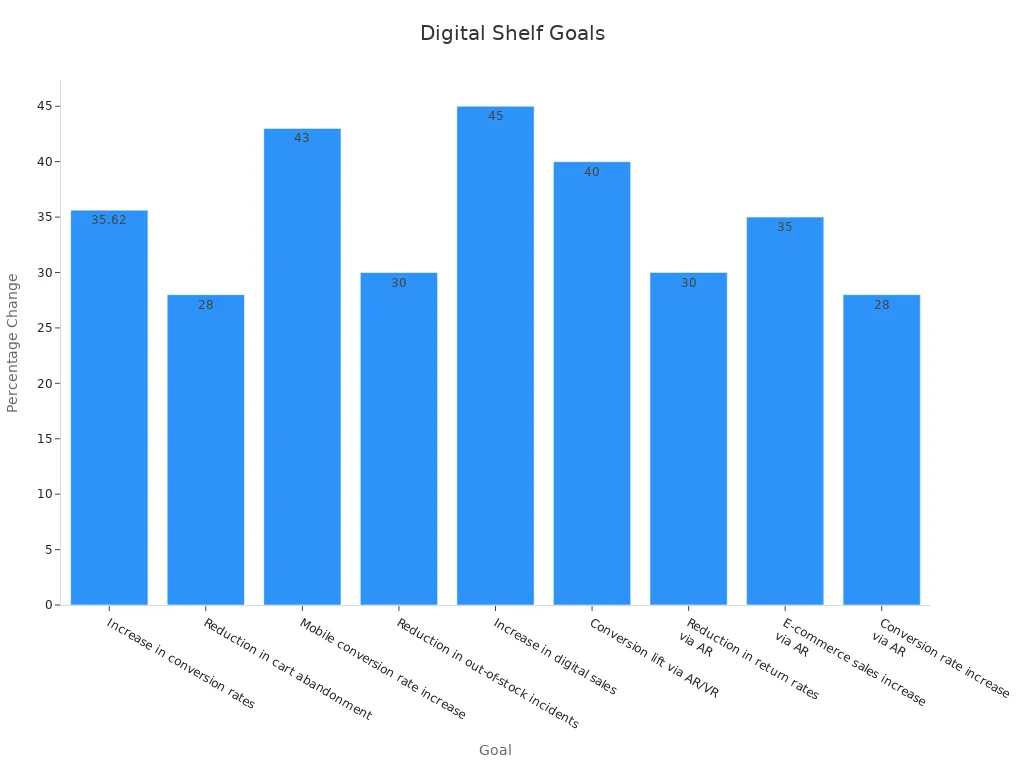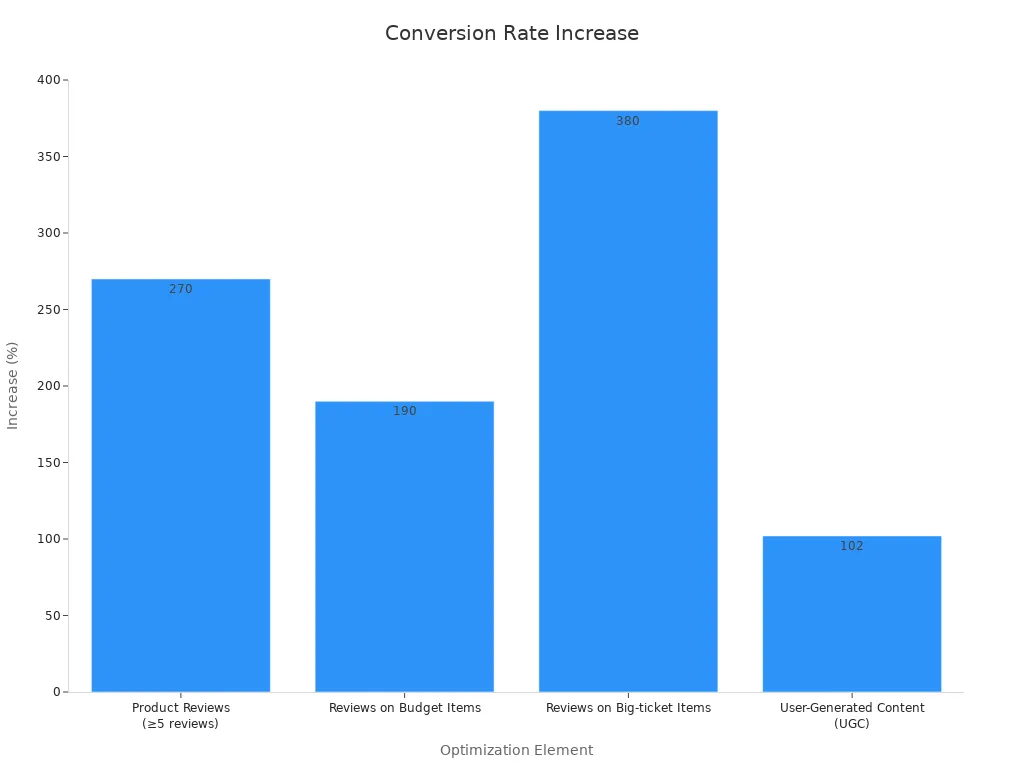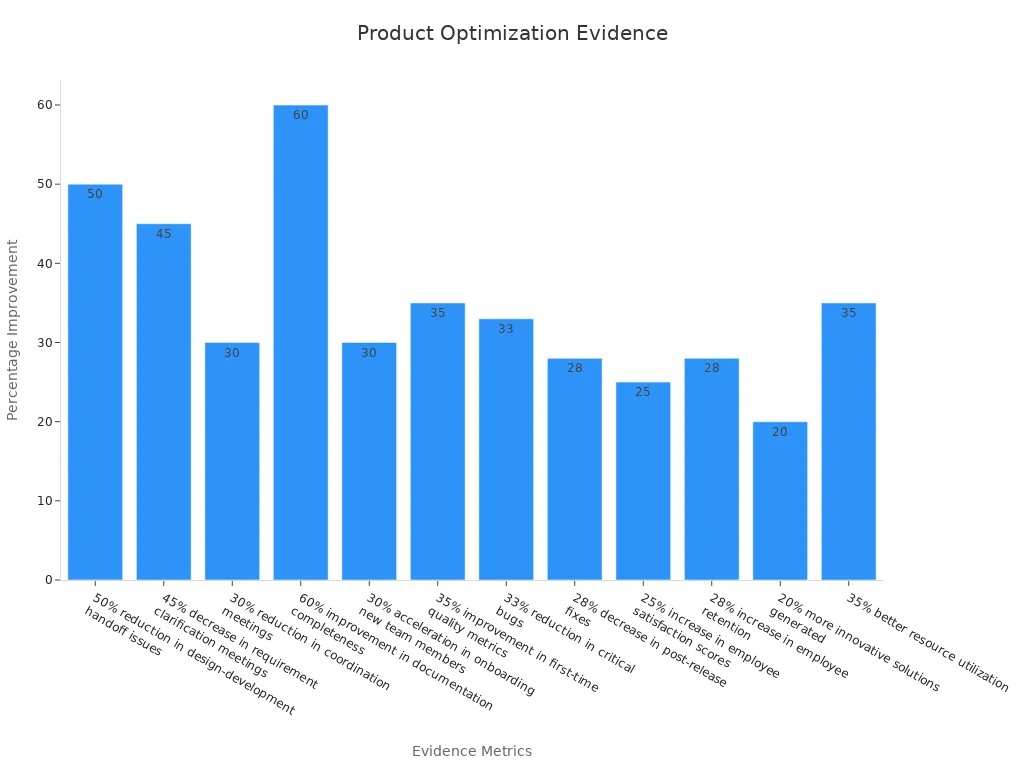
You face intense competition in ecommerce, so a robust digital shelf strategy becomes essential. Product listing optimization boosts product visibility and drives conversions, directly impacting your bottom line. The right digital shelf approach ensures your products stand out, build trust, and earn shopper loyalty.
| Metric / Statistic | Impact on Ecommerce Sales |
|---|---|
| 8.5% year-over-year sales increase | Digital shelf analytics fuel steady monthly growth. |
| 10% sales increase | A single positive review triggers measurable gains. |
| 44% higher sales trajectory | Multiple strong reviews accelerate sales. |
- Optimized digital shelf content, including high-quality visuals and accurate attributes, increases engagement.
- Real-time analytics and consistent product data help you refine your strategy for ongoing success.
- Esl Retail solutions such as Electronic Shelf Labels, ESL Gateway AP, and ESL Price Tag elevate the digital shelf experience.
Building a Winning Digital Shelf Strategy
A successful digital shelf strategy starts with clear goals and a deep understanding of your customers. You need to align your objectives with business outcomes and set measurable KPIs that drive retail growth. Mapping the customer journey helps you identify key touchpoints and tailor your content for every stage, ensuring a seamless customer experience.
Defining Your Digital Shelf Goals
Aligning Objectives with Business Outcomes
You must connect your digital shelf strategy to your broader business objectives. For example, if your goal is to increase sales, focus on improving product visibility and reducing cart abandonment. Many retail leaders set objectives such as boosting conversion rates, increasing inventory accuracy, and enhancing the customer experience. These objectives help you prioritize your efforts and allocate resources effectively.
Tip: Aligning your digital shelf goals with business outcomes ensures every optimization supports your bottom line.
Setting Measurable KPIs for Success
To track progress, you need measurable KPIs. Leading retailers use metrics like conversion rate, cart abandonment, and inventory accuracy to evaluate their digital shelf performance. The table below highlights proven goals and outcomes from top retail brands:
| Measurable Goal | Metric / Outcome | Example / Source |
|---|---|---|
| Increase in conversion rates | +35.62% with one-click checkout | Bolt, 2023 |
| Reduction in cart abandonment | -28% | Bolt, 2023 |
| Mobile conversion rate increase | +43% via Walmart Pay mobile wallet | Walmart, 2023 |
| Inventory accuracy improvement | From 65% to over 95% | RFID technology, HBR, 2023 |
| Reduction in out-of-stock incidents | -30% | Sephora, 2022 |
| Increase in digital sales | +45% via omnichannel fulfillment | Target Annual Report, 2022 |
| Customer lifetime value increase | Proportional to number of integrated channels | Harvard Business Review, 2023 |
| Conversion lift via AR/VR | +40% | ARtillery Intelligence, 2023 |
| Reduction in return rates via AR | -30% | ARtillery Intelligence, 2023 |
| E-commerce sales increase via AR | +35% | IKEA & Sephora, 2023 |
| Conversion rate increase via AR | +28% | IKEA & Sephora, 2023 |

Mapping the Customer Journey
Identifying Key Touchpoints
You must understand where your customers interact with your digital shelf. Key touchpoints include search results, product detail pages, and checkout. Each stage presents unique retail opportunities to engage shoppers and influence their decisions. By mapping these touchpoints, you can identify gaps and optimize the customer experience.
- Search and discovery
- Product comparison
- Purchase decision
- Post-purchase engagement
Tailoring Content to Each Stage
You should customize your content for every stage of the journey. Use high-impact visuals and clear product information during the discovery phase. Highlight unique features and benefits when customers compare products. At checkout, simplify the process to reduce friction and boost conversions. After purchase, provide helpful content and support to build loyalty.
Note: Tailored content at each touchpoint increases engagement and drives higher conversion rates across your retail channels.
Product Listing Optimization for Maximum Product Visibility

You can drive ecommerce growth by focusing on product listing optimization. This process ensures your products stand out, attract attention, and convert browsers into buyers. Enhanced product visibility starts with well-crafted titles, compelling descriptions, and rich visual content. When you optimize every element of your product listings, you create a seamless path for shoppers to find and choose your products.
Crafting High-Impact Titles and Descriptions
Your product titles and descriptions serve as the first impression for shoppers and search engines. Effective product listing optimization begins here.
Integrating Targeted Keywords
You should research and integrate relevant keywords into your titles and descriptions. Using primary keywords improves SEO, making your listings more visible and trustworthy. When you include keywords that match shopper intent, you increase the chances of your products appearing in search results. This approach not only boosts product visibility but also builds trust with your audience.
- Using primary keywords in product titles and descriptions makes listings clear and relevant to both users and search engines.
- Testing different call-to-action phrases helps you discover what motivates your audience.
- Incorporating power words adds excitement and urgency, encouraging immediate action.
Tip: Place your most important keywords at the beginning of your titles for maximum impact.
Highlighting Unique Selling Points
You need to showcase what sets your products apart. Storytelling techniques help you connect emotionally with customers by addressing their needs and pain points. When you break down features into tangible benefits, you make it easier for shoppers to understand the value of your products. Addressing common objections directly in your descriptions builds trust and reduces hesitation.
- Highlight scarcity and urgency with phrases like “limited stock” or “only a few left.”
- Use clear, honest information to answer common questions and reduce purchase hesitation.
| Optimization Element | Conversion Rate Increase (%) | Notes |
|---|---|---|
| Product Reviews (≥5 reviews) | 270% | Products with 5 reviews more likely to be purchased |
| Reviews on Budget Items | 190% | Conversion boost for lower-priced products |
| Reviews on Big-ticket Items | 380% | Conversion boost for expensive products |
| User-Generated Content (UGC) | 102% | Conversion increase when users engage with UGC |

Enhancing Visual Content
Visual content plays a critical role in product listing optimization. High-quality images and engaging videos capture attention and build trust.
Using High-Quality Images and 360° Views
You should use crisp, authentic images that show your products from multiple angles. 360° views allow shoppers to explore every detail, increasing confidence in their purchase decisions. Authentic images build consumer trust, with 73% of shoppers more likely to buy from brands that use them.
- High-quality images can increase conversion rates by up to 63%.
- User-generated photos can boost conversion rates by 4.5% and double consumer trust compared to stock photos.
Incorporating Engaging Videos and Tutorials
Videos and tutorials help shoppers understand how your products work in real life. Shoppable videos generate three times more conversions than traditional videos. Consumers are 85% more likely to purchase after watching a product video.
- Visual content such as images, videos, and infographics can increase user engagement by up to 80%.
- Websites with visually appealing layouts see a 38% lower bounce rate and longer visitor sessions.
Note: Visual storytelling and user-generated content enhance brand connection and authenticity, which boosts both visibility and consumer action.
Optimizing Bullet Points and Attributes
Bullet points and product attributes make your listings easy to scan and understand. This part of product listing optimization improves readability and helps shoppers make quick decisions.
Structuring for Readability and Clarity
You should organize bullet points logically, using short phrases and clear language. This structure allows shoppers to find key information quickly. Optimized bullet points encourage deeper content consumption, as shown by increased page views and scroll depth.
- Metrics like Daily Active Users (DAU), Weekly Active Users (WAU), and Monthly Active Users (MAU) reflect higher engagement when content is easy to read.
- Session Length increases when users find information quickly and stay engaged.
Including Essential Product Details
You must include all relevant product attributes, such as size, color, material, and compatibility. Complete and accurate details reduce customer confusion and returns. Event tracking shows that users engage more with listings that provide comprehensive information.
- Net Promoter Score (NPS) rises when customers feel confident in their purchase decisions.
- Customer Lifetime Value (CLV) grows as shoppers return to brands that provide clear, detailed listings.
Pro Tip: Regularly review and update your bullet points and attributes to reflect new features, customer feedback, and seasonal trends.
Ensuring Data Accuracy and Channel Consistency
Maintaining accurate and consistent product data across all your digital shelf channels is essential for driving conversions and building trust. You need to ensure that shoppers always see the correct product availability, pricing, and attributes, no matter where they browse or buy. Inconsistent or outdated information can lead to lost sales, abandoned carts, and a damaged reputation.
Standardizing Product Information Across Platforms
Synchronizing SKUs, Attributes, and Pricing
You should synchronize SKUs, attributes, and pricing across every platform to guarantee shoppers receive the same information everywhere. A Product Information Management (PIM) system creates a single source of truth by consolidating all product data into one centralized repository. This approach ensures your teams access the same accurate and up-to-date information, which is critical for maintaining product availability and stock accuracy.
- The PIM system validates and cleanses incoming data, checking for duplicates and enforcing standardized formats.
- Automated syndication pushes updates immediately to all sales and marketing channels, keeping product listings current.
- These processes reduce errors, prevent duplication, and guarantee customers receive consistent content, improving data accuracy across channels.
Poor product data quality leads to significant negative outcomes. Incomplete or outdated product information causes 60.7% of online shopping carts to be abandoned. Data quality issues cost organizations an average of $12.9 million annually, highlighting the importance of standardization for your digital shelf.
Preventing Data Discrepancies
You can prevent data discrepancies by standardizing sales figures, measurements, and customer satisfaction metrics. For example:
- Standardize sales figures into a common currency for consistent comparison.
- Use established metrics like Net Promoter Score (NPS) to measure satisfaction.
- Convert all product dimensions to the same unit, such as centimeters.
- Transform raw data into z-scores for comparative analysis.
These practices improve data compatibility and reliability, making it easier to track product availability, stock levels, and buy box status across platforms.
Leveraging Product Information Management (PIM) and Digital Asset Management (DAM) Tools
Streamlining Content Distribution
Implementing PIM and DAM tools streamlines your content distribution. You can automate updates for product listings, images, and videos, ensuring every channel reflects the latest product availability and stock status. This automation reduces manual errors and speeds up time-to-market.
- A European manufacturer managing over 6,000 products improved productivity and reduced errors by integrating PIM and DAM systems. Automation enabled efficient management of product lifecycle, pricing, localization, and order management, resulting in enhanced ROI and faster response to changes in stock and availability.
Maintaining Up-to-Date Listings
You must keep your product listings up to date to maintain buy box status and meet customer expectations. PIM and DAM solutions help you manage digital shelf content efficiently, ensuring that product availability, pricing, and stock information remain accurate across all channels.
Conducting Regular Data Audits
Identifying and Correcting Errors
Regular data audits help you identify and correct errors in your product listings. You should review your digital shelf data frequently to catch discrepancies in stock, product availability, and buy box status before they impact sales.
Ensuring Full Completion of Product Details
Complete product details drive trust and conversions. You need to verify that every listing includes all required information, such as stock levels, product availability, and attributes. This attention to detail ensures shoppers always have the information they need to make confident purchase decisions.
Tip: Schedule routine audits to maintain high data quality and keep your digital shelf competitive.
Optimized Digital Shelf Strategy with Advanced SEO Techniques
A truly optimized digital shelf strategy relies on advanced SEO techniques to boost product discoverability, drive conversions, and maximize your retail media strategy. You need to approach SEO as a core part of your digital shelf, not just an afterthought. By focusing on the right keywords, on-page optimization, and adapting to retailer platform algorithms, you can achieve improved SEO rankings and outperform competitors in the crowded retail landscape.
Conducting Effective Keyword Research
Identifying High-Intent and Long-Tail Keywords
You should start your seo strategy by identifying high-intent and long-tail keywords that match what your customers actually search for. These keywords help you target shoppers who are ready to buy, increasing the effectiveness of your advertising and digital shelf efforts. Use keyword research tools to discover phrases with strong purchase intent and lower competition. This approach ensures your product listings reach the right audience and support your retail media strategy.
Analyzing Competitor Search Terms
You can gain a competitive edge by analyzing the keywords your competitors target. Study their product titles, descriptions, and advertising campaigns to uncover gaps and opportunities. This analysis helps you refine your own digital shelf strategy and ensures your listings remain relevant and visible. By understanding competitor tactics, you can adjust your keywords and content to capture more market share.
Tip: Regularly update your keyword list to reflect changing trends and customer behavior.
On-Page SEO for Product Pages
Optimizing Meta Titles, Descriptions, and URLs
You need to optimize meta titles, descriptions, and URLs for every product page. Place your primary keywords at the beginning of titles and descriptions to improve visibility. Use clear, concise language that appeals to both search engines and shoppers. Structured URLs with relevant keywords make it easier for search engines to index your pages, supporting your overall digital shelf strategy.
Structuring Content for Search Engine Crawling
You should structure your content for easy crawling by search engines. Use headings, bullet points, and schema markup to organize information. This structure not only improves SEO but also enhances user experience. For example, adding product, review, and video schema can generate rich snippets in search results, attracting more clicks and supporting your retail media strategy.
- Conduct thorough keyword optimization in all on-page elements.
- Implement schema markup for products, reviews, and videos.
- Use high-quality images and videos with keyword-rich alt text.
- Optimize page load speed and mobile usability.
Note: Tools like Screaming Frog and AI-powered content analysis platforms help you monitor and refine your on-page SEO for maximum impact.
Adapting to Retailer Platform Algorithms
Customizing Listings for Each Channel
You must customize your product listings for each retail platform. Algorithms like Amazon’s A9 and Walmart’s search engine prioritize listings based on relevance, sales performance, and customer satisfaction. Tailor your titles, descriptions, and attributes to meet each platform’s criteria. This customization increases your chances of ranking higher and getting featured in advertising placements.
- Optimized product listings with relevant keywords and strong sales history receive better visibility.
- Continuous updates and monitoring keep your listings aligned with evolving algorithm requirements.
- Automation tools help you maintain consistency and reduce manual errors across channels.
Monitoring and Improving Search Rankings
You should track your search rankings and adjust your strategy as needed. Use analytics tools to monitor impressions, click-through rates, and conversions. Regularly update your listings to reflect new keywords, trends, and customer feedback. This proactive approach ensures your optimized digital shelf strategy remains effective and supports your retail media strategy.
Real-world results show the power of advanced SEO: Wayfair achieved 34% growth by optimizing images, videos, and search features, while Walmart increased mobile orders by 98% through dynamic pricing and mobile-first optimization.
Leveraging Analytics and Real-Time Metrics for Success

You can unlock the full potential of your digital shelf by leveraging analytics and real-time metrics. These tools help you track core performance metrics, optimize product availability, and drive conversions. When you monitor the right data, you gain the insights needed to make informed decisions and achieve retail success.
Tracking Key Performance Indicators (KPIs)
Monitoring Conversion Rates and Click-Through Rates
You should focus on KPIs that directly impact conversions and product availability. Tracking metrics like interactions per visit, leads generated, and both new and returning visitor conversion rates allows you to identify what drives success on your digital shelf. Analytics tools reveal which calls to action work best, which campaigns generate the most leads, and how well you convert first-time and returning shoppers. This approach helps you refine your advertising and digital shelf strategies for maximum impact.
| KPI | How It Supports Increased Conversion Rates | Tracking & Improvement Methods |
|---|---|---|
| Interactions per Visit | Identifying which calls to action (CTAs) visitors engage with helps remove ineffective CTAs and amplify successful ones, boosting conversions. | Use analytics tools to monitor CTA interactions; optimize CTAs accordingly. |
| Leads Generated | More leads mean more potential customers; improving lead gen campaigns (e.g., incentives) raises conversion rates. | Track sign-ups (e.g., email newsletter); use tools like OptiMonk and HubSpot; segment leads for personalized messaging. |
| New Visitor Conversion Rate | Measures success in converting first-time visitors; tailoring messaging and running A/B tests improves this rate. | Use Google Analytics to track; run A/B tests to optimize messaging and design for new visitors. |
| Returning Visitor Conversion Rate | Indicates customer loyalty and retargeting effectiveness; offering discounts or exit-intent popups can increase conversions. | Track via Google Analytics; use targeted offers and exit-intent popups to encourage purchase completion. |
Analyzing Share of Search and Product Visibility
You need to analyze share of search and product visibility to understand your position in the retail landscape. Digital shelf analytics provide real-time data on how often your products appear in search results and how visible they are compared to competitors. By monitoring these metrics, you can adjust your advertising and content strategies to improve product availability and secure the buy box status.
Using Data to Drive Continuous Improvement
Identifying Underperforming Listings
You can use digital shelf analytics to spot underperforming listings quickly. By regularly reviewing performance data, you identify trends and areas that need enhancement. This process ensures your product availability and stock levels remain optimal, supporting higher conversions and better digital shelf performance.
Running A/B Tests and Implementing Changes
You should adopt a data-driven approach to continuous improvement. The Build-Measure-Learn cycle guides you to build new listing features, measure their impact using analytics, and learn from the results. Running A/B tests on product titles, images, or advertising placements helps you determine what drives increased conversion rates. Real-time tracking tools let you make agile adjustments, ensuring your listings evolve based on evidence, not assumptions.
Tip: Consistent application of data-driven strategies across all retail products leads to scalable improvements and sustained success.
Responding to Market and Competitor Trends
Adjusting Pricing and Inventory Dynamically
You must respond to market shifts by adjusting pricing and inventory in real time. Leading retailers like Amazon update prices every 10 minutes, boosting profits by 25%. Dynamic pricing tools such as Prisync and Competera automate price updates, monitor competitors, and optimize prices using algorithms. These tools help you balance competitiveness, profitability, and product availability while maintaining healthy stock turnover.
| Aspect | Details | Impact / Benefit |
|---|---|---|
| Case Studies | Amazon adjusts prices every 10 minutes, boosting profits by 25%. San Francisco Giants increased revenue by 7% using dynamic ticket pricing. Airlines saw a 20% airfare increase during surge pricing events. | Demonstrates real-world profit improvements and market responsiveness through dynamic pricing. |
| Pricing Tools | Prisync and Competera automate price updates, monitor competitors in real-time, analyze customer behavior, and optimize prices with algorithms. | Enables efficient, data-driven pricing decisions that balance competitiveness and profitability. |
| Key Metrics to Track | Profit margins, revenue growth, stock turnover, customer satisfaction (NPS), conversion rates, average order value. | Helps businesses measure effectiveness and adjust strategies dynamically. |
| Pricing Strategies | Raise prices during high demand, offer discounts during off-peak, adjust prices based on inventory levels and competitor actions. | Maximizes profits, clears inventory, and maintains market competitiveness. |
| Risks and Challenges | Customer trust issues, technical errors, ethical concerns. | Highlights the need for transparency, price boundaries, and human oversight to maintain brand reputation. |
Reacting to Shifts in Customer Demand
You need to monitor digital shelf analytics to react quickly to changes in customer demand. Real-time data on product availability and stock levels allows you to adjust advertising, pricing, and inventory strategies. This agility ensures you never miss opportunities for conversions and helps you maintain a strong retail presence.
Note: Regular review of your digital shelf analytics and core performance metrics keeps your retail strategy aligned with market trends and customer expectations.
Integrating Immersive and Personalized Elements for Digital Shelf Success
You can elevate your digital shelf by integrating immersive and personalized features that transform how shoppers interact with your products. These elements not only boost engagement but also create a memorable customer experience that drives conversions and loyalty.
Adding Rich Media and Interactive Features
Incorporating AR, 360° Images, and Product Demos
You can help shoppers make confident decisions by offering high-quality visuals, 360° product views, and interactive demos. Augmented reality (AR) and virtual reality (VR) experiences allow customers to visualize products in their own space, increasing their understanding and trust. Research shows that high-quality visual content, including 360° images and videos, increases the likelihood of purchase by 85%. AR and VR also enhance product interaction, leading to higher engagement and a more satisfying customer experience.
| Feature/Technology | Benefit to Digital Shelf Performance |
|---|---|
| AR and VR immersive experiences | Enhance product interaction, increase customer engagement |
| High-quality visual content (images, 360° views) | Help customers better understand products, increase purchase likelihood |
Using Tutorials and How-To Videos
You can further support shoppers by providing tutorials and how-to videos. These resources demonstrate product use and answer common questions, reducing uncertainty. Shoppers who watch product videos feel more informed and are more likely to complete a purchase. This approach improves the overall customer experience and encourages repeat visits.
Showcasing Customer Reviews and Social Proof
Encouraging Authentic Feedback and Ratings
You should encourage customers to leave honest feedback and ratings. Authentic reviews build trust and influence purchase decisions. Eye-tracking studies reveal that shoppers pay close attention to both positive and negative reviews, which directly impacts their buying choices. Most consumers cannot easily detect fake reviews, so transparency and authenticity remain crucial.
Highlighting Top Reviews and Sentiment Analysis
You can highlight top reviews and use sentiment analysis to showcase the most relevant feedback. Shoppers often focus on emotional content and perceived credibility when reading reviews. By surfacing helpful and credible comments, you guide customers toward confident decisions and foster greater engagement.
- Positive reviews increase purchase likelihood.
- Emotional and credible reviews influence consumer behavior.
Personalizing the Shopping Experience
Dynamic Content Based on User Behavior
You can personalize the digital shelf by displaying dynamic content tailored to each shopper’s behavior. AI and machine learning analyze browsing patterns, purchase history, and preferences to present relevant products and offers. This approach replicates the helpfulness of an in-store assistant, making the customer experience seamless and intuitive.
Tailored Product Recommendations
You can further enhance the customer experience by offering tailored product recommendations. Data-driven personalization uses behavioral and demographic data to suggest products that match individual needs. This strategy reduces the effort required to find the right items, increases average order value, and boosts engagement. Personalized shopping journeys lead to higher satisfaction, loyalty, and conversion rates.
Tip: Integrate immersive and personalized features across all channels—online, mobile, and in-store—to maximize sales and customer engagement.
Establishing a Continuous Optimization Cycle for Sustained Success
A continuous optimization cycle keeps your digital shelf competitive and responsive. You need to set up regular review processes, foster collaboration across teams, and stay ahead of industry changes. This approach ensures your digital shelf analytics deliver actionable insights and help you seize new opportunities.
Setting Up Regular Review and Audit Processes
Scheduling Content and Data Audits
You should schedule audits for your product content and data at regular intervals. Quarterly or monthly audits help you spot underperforming product detail pages by tracking sessions, unique visitors, engagement rates, and conversions. Prioritize your audit results into high, medium, and low categories. This method lets you focus on the most critical updates first. Building an editorial calendar based on audit findings ensures you address issues promptly and keep your digital shelf analytics up to date.
- Track key metrics like time on page and conversions.
- Conduct SEO, technical, and usability audits.
- Organize updates by priority.
- Use an editorial calendar for ongoing improvements.
Refreshing Product Detail Pages (PDPs)
You need to refresh your product detail pages regularly. Performance audits reveal issues with site speed and loading times, which directly affect user experience and conversion rates. Regular updates ensure your product pages remain optimized and effective. This process supports your overall optimization strategy and keeps your digital shelf analytics accurate.
Tip: Consistent audits and updates prevent outdated content from hurting your brand’s reputation.
Collaborating Across Teams for Optimization
Aligning Marketing, Merchandising, and Support
Cross-team collaboration drives better optimization outcomes. When marketing, merchandising, and support teams align, you reduce handoff issues and speed up development cycles. For example, companies have seen a 50% reduction in design-development handoff issues and a 45% decrease in requirement clarification meetings. Improved documentation and onboarding accelerate team productivity and reduce errors.
| Evidence Category | Metric/Outcome | Impact |
|---|---|---|
| Process Improvements | 50% reduction in handoff issues | Faster development cycles |
| Documentation | 60% improvement in completeness | Fewer errors, better onboarding |
| Product Quality | 35% improvement in first-time quality metrics | Higher customer satisfaction |
| Time-to-Market | 25-40% faster for new features | Quicker response to market demands |
| Employee Health | 25% increase in satisfaction | Sustained collaboration and innovation |

Incorporating Customer Feedback into Updates
You should use customer feedback to guide your updates. Direct input from shoppers helps you identify pain points and refine your product listings. This feedback loop ensures your optimization efforts address real user needs, improving both product quality and customer satisfaction.
Staying Ahead of Industry and Regulatory Changes
Adapting to New Technologies and Trends
You must adapt quickly to new technologies and trends. The digital shelf analytics market is projected to grow from $1.68 billion in 2024 to $4.48 billion by 2033. AI, machine learning, and omnichannel strategies drive this growth. Real-time monitoring lets you spot stock outs, pricing errors, and competitor moves, giving you a clear advantage.
Monitoring Compliance and Platform Updates
You need to monitor regulatory changes and platform updates. Compliance with privacy laws like GDPR and CCPA builds trust and keeps your operations legal. Continuous updates to your digital shelf strategy help you stay competitive as e-commerce and omnichannel retail evolve.
- Real-time data collection and automation enable fast, accurate updates.
- Automation reduces manual errors and operational costs by up to 90%.
- Consistent product information improves brand perception and loyalty.
Note: A continuous optimization cycle, powered by digital shelf analytics and automation, ensures you maintain accuracy, agility, and customer trust.
You drive ecommerce success by building a robust digital shelf strategy and optimizing product listings. Focus on maximizing product visibility, maintaining data accuracy, and leveraging advanced SEO. Use analytics to guide continuous improvement and embrace immersive, personalized elements to stand out in retail.
- 85% of shoppers value product information and images when choosing a retail brand.
- On Instacart, 40–50% of purchased items come from search, showing the power of product findability in retail.
- Digital Shelf Analytics and Product Information Management systems help you monitor KPIs like search rankings and customer lifetime value.
- Enhanced content and ongoing optimization boost retail engagement and drive growth.
FAQ
What is digital shelf optimization?
Digital shelf optimization means improving your online product listings to increase visibility, accuracy, and conversions. You focus on content, images, data consistency, and SEO to help shoppers find and choose your products.
How often should you update product listings?
You should review and update product listings at least quarterly. Frequent updates ensure accuracy, reflect new features, and respond to customer feedback or market trends.
Why does data consistency matter across channels?
Consistent data builds trust and prevents confusion. Shoppers expect the same product details, pricing, and availability everywhere. Inconsistent information can lead to lost sales and damage your brand reputation.
Which metrics best measure digital shelf performance?
Key metrics include conversion rate, click-through rate, share of search, product visibility, and inventory accuracy. You should track these KPIs to evaluate and improve your digital shelf strategy.
How do immersive elements like AR or 360° images impact sales?
Immersive elements help shoppers visualize products, increasing confidence and engagement. You can boost conversion rates by making the online experience more interactive and informative.
What tools help manage digital shelf content?
You can use Product Information Management (PIM) and Digital Asset Management (DAM) systems. These tools centralize product data and media, automate updates, and ensure consistency across all channels.
How can you personalize the digital shelf experience?
You personalize by using AI to analyze shopper behavior and recommend relevant products. Dynamic content and tailored suggestions create a more engaging and effective shopping journey.
What are the risks of not optimizing your digital shelf?
Failing to optimize leads to lower visibility, lost sales, higher return rates, and reduced customer trust. You risk falling behind competitors who invest in digital shelf excellence.


